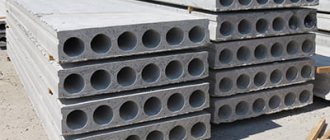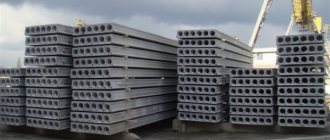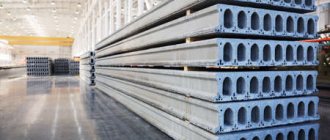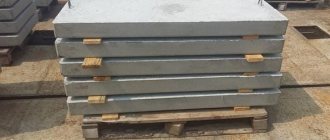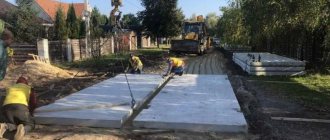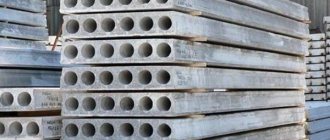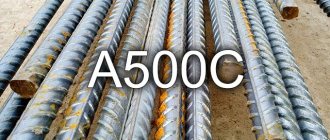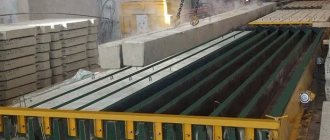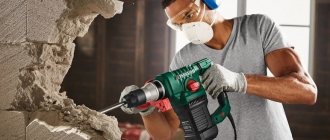Differences between PB and PC floor slabs
Hollow-core slabs PB and PC are widely used to create floors. Common types of such products are slabs of the PB and PC categories. There is a lot in common between them, but there are also significant differences. Both types of products are manufactured in accordance with GOST 9561-2016. Externally, they are large-sized flat elements of rectangular cross-section, in which voids are made parallel to the long side.
How do PB slabs differ from PC slabs: They can be distinguished from each other by several characteristics:
- The holes in the body of PC slabs are round, which explains their name - round-hollow slabs. Most often their diameter is 159 mm. But in different types of these slabs there are variations in the parameter: from 114 mm. in 7PK up to 203 mm. in 6pcs. In PB slabs, the holes have a more elongated, oval shape, with a diameter of 60 mm.
- PC boards are equipped with mounting loops. PB panels may not have them. Their elongated edges are specially shaped for gripping by rigging mechanisms.
- The surface of PB slabs is more perfect due to the peculiarities of the production technology - without the use of formwork. This method determined the name of the element - formless slabs.
- Formless PB slabs can reach a length of 12 m. The maximum length of round-hollow panels is slightly more than 7 m.
| PB plate Buy PB slab at the concrete goods plant | PC plate Buy PC slab at the concrete goods plant |
Both types of slabs are used in civil, industrial construction, and the construction of public buildings. Knowledge of the nuances of production of building elements of these two categories, their pros and cons helps to make the right choice.
Reinforced concrete slabs PC and PB: main differences and characteristics
Home |Blocks and floors |PB and PC floor slabs - what's the difference?
Date: March 13, 2017
When carrying out activities related to the construction of residential buildings and industrial facilities, reliable reinforced concrete floors are used, installed between floors. At construction sites, similar-looking reinforced concrete products are stacked in stacks. It is difficult for the average person to find the difference between them. Only builders and designers can confidently distinguish PB floor slabs from externally similar PC slabs.
The products are used as connecting elements of building structures in the formation of interfloor sections of prefabricated and precast-monolithic buildings. Designers pay primary attention to the safety margin of floors, which affect the stability of the structure. In the construction of modern buildings, PC and PB floor slabs, which have much in common, are widely used. They are made of durable concrete, reinforced with prestressed reinforcement, and are resistant to fire and moisture. Air cavities effectively dampen noise and provide reliable sound and thermal insulation. However, there are differences.
A hollow-core floor slab (PC) is a flat rectangular concrete block
When dealing with construction issues, it is important to know how the products differ and what the technical characteristics are. Therefore, we will consider in detail the operational parameters of the products, and figure out what the difference is between them.
Why choose reinforced concrete
Each of the existing building materials has advantages in use. When choosing the right one, you must first of all focus on the type of building and the tasks assigned to it. Wooden coatings are more flexible, lightweight and natural in origin, but are also very susceptible to pests and have a shorter service life compared to concrete varieties
In addition, it makes sense to take into account the difference in size of wooden floor beams and concrete ones
You can find out what kind of ribbed floor slabs they are: dimensions, GOST, by reading the article.
Among the disadvantages of reinforced concrete structures, it is necessary to note the significant weight and the use of special equipment. Despite this, the labor intensity of wooden floors will be significantly higher and the process itself will be longer compared to ready-made concrete slabs.
The video shows the range and dimensions of floor slabs:
Types of slabs
2 types of floor panels are produced, marked PB and PC.
They are similar in the following performance indicators:
- resistance to moisture;
- high strength characteristics;
- both building materials are non-flammable;
- noise absorption.
But, despite these similarities, reinforced concrete structures have significant differences related to the technology of their production. Only experienced builders can tell the difference between them by appearance.
Reinforced concrete products marked PB are produced using formless technology. For this purpose, special installations using vibration compaction are used. The length of the product is set by the customer of the building material, but not more than 12 m.
Manufacturing technology of PB brand reinforced concrete products:
- the concrete mass moves continuously along the conveyor line;
- When hardening, the concrete is cut to the specified length.
- metal formworks of established sizes, additionally equipped with reinforcing mesh and steel rods, are filled with concrete mixture;
- concrete poured into a metal frame is subjected to vibration compaction;
- heat treatment of reinforced concrete is carried out;
- After hardening and drying, the finished product is removed from the formwork structure.
The maximum length of the PC is 7.2 m.
Properties of products designated PC
Technical characteristics of reinforced concrete slabs marked PC:
- used for the construction of any type of building structures;
- production time is 2 weeks, which helps reduce construction time;
- PCs are additionally reinforced with metal or special stressed reinforcement;
- have group 3 resistance to cracking;
- vibration-resistant building material;
- increased soundproofness;
- not afraid of moisture;
- increased resistance to high temperatures.
The formwork panels are equipped by the manufacturer with special mounting lugs, which make them easier to move. This is their main difference from formless structures.
The PC board has steel eyes for transportation and installation.
Advantages of building materials
Many professional builders point out that due to innovative methods for manufacturing floor slabs for multi-story buildings with the PB label, they have great potential. For example, the length of the reinforced concrete product itself may be non-standard, which will allow the customer to vary the types of slabs with dimensions of 1.8-9 meters.
An important factor is reducing the weight of PB products to 5-6%, which is impossible without the use of a formless production method. We talked above about the possibility of sawing the material, which allows them to be used to cover bay windows.
Slabs created using the constant formation of concrete mortar without the use of formwork have the following set of technological characteristics:
High margin of noise insulation.
Smooth and smooth outer surface of products.
Withstands impressive mechanical and shock loads.
Excellent safety margin.
Use for construction even in the most extreme climatic regions.
Explanation of symbols
Types of overlap are marked with letters; the number in front of them is indicated for hollow-core varieties and characterizes the diameter of the internal holes. Examples of possible designations and their interpretation for popular solid types are given in the table:
| Marking | Type and features of the plate |
| P, PP, PTS | Solid monolithic floors |
| PG, PR | Solid ribbed slab |
| PV | The same, with openings for ventilation |
| PS, PF | Same with holes for lights |
| PL | The same for an easily removable roof |
| POV, POS, POF, POL | Arched and vaulted ribbed slabs with similar properties |
The marking of hollow-core panels includes a letter designation of the number of sides that support the slab (“T” corresponds to three, “K” to four). The absence of a third letter implies support for the structure on both sides. Decoding of the main types in this case:
| Designation of slabs | Thickness, mm | Type of voids, features | Nominal distance between centers of voids in slabs, not less than mm | Diameter, mm |
| 1 PC (1 may not be specified) | 220 | Round | 185 | 159 |
| 2pcs | 140 | |||
| 3pcs | 127 | |||
| 4pcs | 260 | The same, with cutouts in the upper zone along the contour | 159 | |
| 5pcs | Round | 235 | 180 | |
| 6pcs | 233 | 203 | ||
| 7pcs | 160 | 139 | 114 | |
| PG | 260 | Pear-shaped | Assigned in accordance with the parameters of the molding equipment of the manufacturer of hollow core slabs | |
| PB | 220 | Manufactured by continuous forming |
The main difference between PC and PG panels and PB panels is the manufacturing method: the first two are poured into formwork structures, the latter is molded continuously (conveyor technology). As a result, floors marked PB have a smoother surface that is protected from external influences. They are less limited in length and are suitable for rooms with non-standard dimensions. The disadvantages of molding plates include narrower holes (the diameter of the voids when marking PB does not exceed 60 mm), unlike PC and PG, they cannot be drilled through for laying communications, at least this rule applies to high-rise buildings.
The length and width of each type are also limited by the standard; they are indicated in decimeters and rounded up. The actual size of reinforced concrete hollow-core slabs is usually 10-20 mm smaller. The following digital designation characterizes the design load of the slab; this indicator depends on the quality of the concrete and the reinforcement metal used. The reinforcement class is not always indicated; its mention is mandatory only for prestressed structures. If necessary, its designations are guided by the technical conditions for reinforcing steel.
The next marking point concerns the brand of concrete used (not indicated for heavy groups). Other types include: cellular (I), light (L), dense silicate (S), fine-grained (M), heat-resistant (W) and sand concrete (P) compositions. For floor slabs intended for work in conditions of exposure to aggressive environments, resistance is indicated in letter terms: normal permeability (N), reduced (P) and especially low (O). Another indicator is seismic resistance: structures designed for such loads are designated with the letter “C”. All additional features are indicated in the product labeling in Arabic numbers or letters.
Cost of slabs
| Marking | Dimensions: L×W×H, cm | Weight, kg | Load-bearing capacity, kg/m2 | Retail price per piece, rubles |
| Hollow core slabs with round holes supported on 2 sides | ||||
| PC-16.10-8 | 158×99×22 | 520 | 800 | 2940 |
| PC-30.10-8 | 298×99×22 | 880 | 6000 | |
| PK-60.18-8 | 598×178×22 | 3250 | 13340 | |
| PK-90.15-8 | 898×149×22 | 4190 | 40760 | |
| Floor slabs, bench formless formation. Products are placed on 2 end sides | ||||
| PB 24.12-8 | 238×120×22 | 380 | 800 | 3240 |
| PB 30.12-12 | 298×120×22 | 470 | 1200 | 3950 |
| PB 100.15-8 | 998×145×22 | 2290 | 800 | 29100 |
| Ribbed ceilings without an opening in the shelf | ||||
| 2PG 6-3 AIV t | 597×149×25 | 1230 | 500 | 12800 |
| 4PG 6-4 AtVt | 597×149×30 | 1500 | 820 | 14150 |
Differences between floor slabs.
- In demand for the construction of both typical and individual buildings
- Less expensive
- Easy to install
The pouring and forming process differs significantly from the production of formless slabs.
- Smoother and more even.
- Wide load range.
- Produced using modern technologies.
- More expensive.
- Accelerated construction rates thanks to fast slab production.
- It is possible to make slabs to individual sizes and with oblique ends.
The main advantage of such plates is a higher quality surface and the ability to obtain various precise dimensions of products.
Purely visually, the differences between PC and PB boards are practically invisible.
- Only by special transport
- Strictly in a horizontal position with thorough fixation of all elements
- Storing products in a stack of 8 pieces, wooden spacers are placed between the layers
- The installation of folded blocks is positioned in such a way that the markings are visible
Both types of slabs undergo thorough testing; the integrity of building structures, as well as the absence of cracks, breaks, and deformations, depend on their reliability and sufficient strength and rigidity.
Advantages of formless floor slabs
PB reinforced concrete products have many advantages:
- Minimum tolerances – provide perfectly accurate geometric dimensions, which facilitates installation work.
- Wide selection of standard sizes - cutting is carried out after molding, so the slabs are produced in lengths from 1.6 to 10.8 m in increments of 100 mm.
- Possibility of cutting the end part at any angle.
- The absence of reinforcing mesh in the design makes it easier and faster to form channels for utility lines.
Photo 5. Floors made of PB slabs
The absence of mounting brackets in the design of formless slabs makes it necessary to use special rigging devices for loading, unloading and installation.
Classification according to GOST
The production of this building element is carried out strictly according to GOST 23009-78, developed back in 1979. This standard provides for the main indicators of the finished product and its applicability for the construction of buildings and structures of varying functionality. Floor slabs of industrial production must have a special designation, in which all the necessary information is “encrypted”. What are the dimensions of reinforced concrete floor slabs can be found here.
Products are classified according to all indicators:
- Construction type.
- Dimensions.
- Class of fittings used.
- Type of concrete.
- Additional resistance to external influences.
- Design features.
In the article you can learn about the sizes of hollow core floor slabs according to GOST.
In order to have an idea of all the possible options and PC decryptions, let’s consider each of the above parameters separately in a little more detail.
Type of construction according to GOST classification
The standard size of the product must be indicated in capital letters, the maximum number of which should not exceed three units.
You can learn about hollow core floor slabs and their technical characteristics from the article here. You can learn about possible options for filling the openings between floor slabs, what to choose from foam block or gas block and which material is better here.
Basic designations for the type of construction of reinforced concrete products:
| No.: | Symbol: | Product name: |
| 1. | WITH | Piles. |
| 2. | F | Foundations (column, tile). |
| 3. | FL | Strip foundations. |
| 4. | FO | Foundations for equipment. |
| 5. | FB | Foundation blocks. |
| 6. | BF | Foundation beams. |
| 7. | TO | Columns. |
| 8. | CE | Column racks (for pipelines). |
| 9. | R | Crossbars. |
| 10. | B | Beams (general designation). |
| 11. | BC | Beams for cranes. |
| 12. | BO | Strapping beams. |
| 13. | BP | Rafter beams. |
| 14. | BS | Rafter beams. |
| 15. | BE | Beams for overpasses. |
| 16. | BT | Tunnel beams. |
| 17. | FP | Rafter trusses. |
| 18. | FS | Rafter trusses. |
| 19. | P | Monolithic floor slabs. |
| 20. | PD | Bottom slabs for tunnels and channels for communications. |
| 21. | PT | Floor slabs for tunnels and channels for communications. |
| 22. | OK | Channel trays. |
| 23. | PC | Floor pits with round voids. |
| 24. | PP | Parapet slabs. |
| 25. | BY | Slabs for windows. |
| 26. | OP | Support cushions. |
| 27. | LM | Flights of stairs. |
| 28. | LP | Staircase landings. |
| 29. | PM | Stair steps. |
| 30. | LB | Stair beams, stringers. |
| 31. | SB | Wall blocks. |
| 32. | C-Sec | Basement wall blocks. |
| 33. | PS | Wall panels. |
| 34. | PG | Partition panels. |
| 35. | ETC | Jumpers. |
| 36. | ST | Walls for supports. |
| 37. | Sh | Reinforced concrete sleepers for railways. |
| 38. | T | Non-pressure socket reinforced concrete pipes. |
| 39. | TF | Reinforced concrete non-pressure seam pipes. |
| 40. | TN | Vibrohydropressed reinforced concrete pressure pipes. |
| 41. | BT | Concrete pipes. |
You can select suitable products according to the main purpose. If the design can have several standard sizes, the letter designation can be supplemented with a number. Consequently, for reinforced concrete floor slabs with round voids, the product marking will begin with “PC”, monolithic structures “P”, the remaining designations will be deciphered further.
You can learn more about what floor slabs are needed for a private home by reading the article.
Advantages of floors
Before choosing a particular brand, it is worth considering what the advantage of purchasing is. To do this, we propose to briefly consider all the advantages.
Designs marked PC have the following advantages:
- excellent for quick construction due to short production times - up to 14 days - however, this increases the price of the product;
- the product can be used in buildings of any type;
- the slab has stressed or standard types of steel rods inside;
- due to the manufacturing features, it is possible to significantly reduce vibrations and protect the room from extraneous sounds, maintaining a warm atmosphere;
- the structure was assigned the third group of crack resistance;
- insensitive to moisture;
- can withstand high temperatures;
- the structure is equipped with special eyes that facilitate installation work and reduce the weight of the room - this is a significant difference from PB brand slabs, which, in turn, do not have sling elements.
Just like the design described above, undecked products have a number of advantages that must be taken into account when making a direct choice.
- Externally, the quality of the product is much better due to the smooth surface. This is achieved using special machines that do not stop working, which gives the structure a more aesthetic appearance.
- The PB board has clear geometric dimensions during manufacturing, which ultimately allows it to achieve an ideal shape. Installation work becomes much easier.
- Production using innovative technologies with the use of cable reinforcement in the structure, as a result of which surface tension, which provokes the occurrence of cracks on the surface, is completely eliminated.
- The ability to set the required shape - 2.6 meters - in general, the size that you need. There is no need to worry about measurement errors, since the product is manufactured with an accuracy of up to 0.1 meters.
- Ability to withstand enormous loads by expanding the range depending on the size of the slab.
- The slab has a pre-reinforcement product inside, regardless of its size.
- It is possible to form the end at the angle required by the developer.
- Easy formation of holes inside the ceiling.
Load calculation
Calculation of limiting impact
Calculation of the limiting impact is a mandatory condition when designing a building. The dimensions and other parameters of the panels are determined by the old, good Soviet GOST number 9561-91.
Construction of a hollow core slab with a reinforced screed
In order to determine the load that will be exerted on the product, it is necessary to indicate on the drawing of the future structure the weight of absolutely all elements that will “press” on the ceiling. Their total weight will be the maximum load.
First of all, you need to consider the weight of the following elements:
- cement-sand screeds;
- gypsum concrete partitions;
- weight of flooring or panels;
- thermal insulation materials.
Subsequently, all the obtained indicators are summed up and divided by the number of panels that will be present in the house. From here you can get the maximum, maximum load on each specific product.
Calculation of optimal load
It is clear that the maximum permissible level is a critical indicator, which should not be increased to under any circumstances. Therefore, it is best to calculate the optimal indicator. For example, a panel weighs 3000 kg. It is needed for an area of 10 m².
It is necessary to divide 3000 by 10. The result is that the maximum permissible load value will be 300 kilograms per 1 m². This is a small indicator, but you also need to take into account the weight of the product itself, for which the load was also calculated (let’s say its value is 800 kilograms per 1 m²). From 800 you need to subtract 300, the result is 500 kilograms per 1 m².
Now you need to roughly estimate how much all the loading elements and objects will weigh. Let this figure be equal to 200 kilograms per 1 m². From the previous indicator (500 kg/m²) you need to subtract the resulting one (200 kg/m²). The result will be a figure of 300 m². But that's not all.
Diagram of a hollow core slab with waterproofing
Now from this indicator it is necessary to subtract the weight of furniture, finishing materials, and the weight of people who will constantly be in the room or house. “Live weight” and all elements, their load, let it be 150 kg/m². From 300 you need to subtract 150. As a result, you will get the optimal permissible indicator, the designation of which will be 150 kg/m². This will be the optimal load.
Disadvantages of PB slabs:
- The absence of mounting loops complicates the connection of the slabs with each other and the process of installing them in the design position; it becomes necessary to use clamps.
- The impossibility of punching holes in PB slabs due to the insufficient width of the holes, which complicates the installation of intra-house communications, in contrast to PC slabs, the round shape and sufficiently large diameter of the voids will allow punching holes for pipes without affecting the reinforced ribs.
For comparison, the width of the hole in the PB floor slab is 60 millimeters, while in PC series slabs the width of the hole is 159 millimeters, which will allow pipes with a diameter of 100 millimeters to be passed through them without difficulty. Sometimes experts allow punching holes for low-rise construction, but this procedure is undesirable. Using this link you can buy FBS foundation blocks https://mixmaterials.ru/prodazha-fundamentnyih-blokov.html at the price of the manufacturer.
What are the advantages of formless PB floor slabs?
The performance characteristics of the products are similar. However, there are fundamental differences. Plates with the abbreviation PB, manufactured without formwork, differ from similar panels cast into formwork.
The main advantages of products manufactured on a conveyor belt:
- high quality of the working surface of the products. It is due to the use of professional equipment that ensures the molding of products during continuous movement. Thanks to the smooth surface, the products are visually different from PC panels that have significant flatness deviations;
- minimum tolerances ensuring precise geometric parameters and ideal product configuration. Products with precise dimensions and correct geometry are easier to install, which greatly facilitates installation work;
- the use of a modern production method, which involves strengthening the concrete mass with tensioned cables. They provide increased strength to concrete and also reduce the likelihood of cracks due to mechanical stress;
- technological ability to produce panels with different geometric dimensions. Dimensions can change in increments of 10 cm. At the same time, the length of the product, depending on customer requirements, can vary in the range of 2–12 meters;
- the presence of pre-stressed cables, regardless of the dimensions of the products. This increases the strength characteristics of the concrete mass, which is capable of withstanding forces per square meter of area in the range from 600 to 1450 kg;
- the ability to make the end plane at an incline at the individual request of the client. This expands the range of use of panels intended for making floors in buildings of non-standard configuration;
- the ability to easily make holes in concrete for connecting communications. The absence of a frame made of steel rods facilitates the formation of communication channels.
Dimensions and weight
The presented products are produced in standard dimensions. They are taken into account when designing houses. For example, the standard width can be 6, 10, 12, 15 cm. The length is characterized by the following dimensions: 24-90 cm, and the thickness of the product can reach 22 cm. Floor slabs of non-standard sizes can be produced, but this is done only on an individual order. When lifting such products, it is necessary to use powerful lifting equipment, since the weight of the structures can reach 1.2-3.44 tons.
Types of hollow core slabs
In addition to standard PC boards, there are several other varieties:
- PB – slabs produced by formless forming on a conveyor belt. During the manufacturing process, a special reinforcement method is used, which allows the slabs to be cut without losing their strength. PB has a smoother surface, which makes it easier to finish floors and ceilings.
- PNO - lightweight slabs, also manufactured without formwork. The main difference from PB is the smaller thickness, which is 160 mm.
- NV is an internal type of decking with one row of prestressed reinforcement.
- NVK is an internal type of flooring, but with two rows of stressed reinforcement and a thickness of 265 mm.
The device and components of supporting the slab
